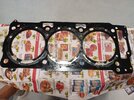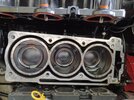I just rebuilt the top end of a 2004 RXP that had a burnt piston. I bored it to 100.5mm and replaced the head with a used one which I sent out for a valve job and surface check. I also replaced the rod and main bearings. I put it together with new aftermarket rocker bolts and head gasket and OEM head bolts.
During the first three hours of break in, I capped it at 7000 RPMs. After that, I started opening it up. It accelerated to 8000 RPMs without any issues the first few times, so I ran it wide open for about a half mile until the temperature alarm came on. I let off and drifted. The alarm cleared in a few seconds, so I shut it off for a few minutes to let it cool, then idled it back home.
Upon examination, I found that about a quart of coolant had been pushed out of the overflow. I topped it off, put a catch can on the overflow hose and returned to the bay to perform a series of tests. I took a non-contact thermometer to check the cylinder head return hose temperature.
I ran it for about a half hour at or below 7000 RPM, stopping periodically to check the catch can and coolant temperature. I didn’t lose any coolant and the temperature held right around 190°F. I then opened it up for about 15 seconds. It pulled to 8000 RPMs easily, but the catch can was full afterwards. The temperature remained at 190.
I took it back home to pressure test the cooling system. The cap would only hold to 9 psi, but the rest of the system held fine, so I replaced the seal on the cap, which allowed it to hold to 15psi. Taking it back to the bay, it continued to spew coolant after about 15 seconds at WOT, but it started struggling to reach 8000 RPM. The coolant temperature continues to stay around 190°. I returned home to check the compression while it was still at operating temperature. It measured 137, 135, and 137psi (cylinders 1, 2, and 3).
Checking forum posts, I read that the 215 RXPs are somewhat notorious for head gasket leaks and that a symptom is spewing coolant out of the overflow. The forum posts never arrived at any conclusions or solutions. I tried one last experiment before taking the head back off. I torqued all of the head bolts an additional 90°, but it still only pulled to 7500 RPM.
When I pulled the head back off, it appears to me that the cylinder side of the head gasket was compromised. I am no expert, but the absence of coating most likely indicates a leak. There was not much residual stuck to the corresponding cylinder deck, so it seems the missing coating was pushed into the coolant jacket. I did recover what appeared to be coating in the coolant that I drained before removing the head. I saw one suspicious characteristic of the head gasket that possibly contributed to a failure. The alignment dowel hole at the #3 cylinder end of the gasket was large, allowing what I thought to be a questionable amount of misalignment.
During the first three hours of break in, I capped it at 7000 RPMs. After that, I started opening it up. It accelerated to 8000 RPMs without any issues the first few times, so I ran it wide open for about a half mile until the temperature alarm came on. I let off and drifted. The alarm cleared in a few seconds, so I shut it off for a few minutes to let it cool, then idled it back home.
Upon examination, I found that about a quart of coolant had been pushed out of the overflow. I topped it off, put a catch can on the overflow hose and returned to the bay to perform a series of tests. I took a non-contact thermometer to check the cylinder head return hose temperature.
I ran it for about a half hour at or below 7000 RPM, stopping periodically to check the catch can and coolant temperature. I didn’t lose any coolant and the temperature held right around 190°F. I then opened it up for about 15 seconds. It pulled to 8000 RPMs easily, but the catch can was full afterwards. The temperature remained at 190.
I took it back home to pressure test the cooling system. The cap would only hold to 9 psi, but the rest of the system held fine, so I replaced the seal on the cap, which allowed it to hold to 15psi. Taking it back to the bay, it continued to spew coolant after about 15 seconds at WOT, but it started struggling to reach 8000 RPM. The coolant temperature continues to stay around 190°. I returned home to check the compression while it was still at operating temperature. It measured 137, 135, and 137psi (cylinders 1, 2, and 3).
Checking forum posts, I read that the 215 RXPs are somewhat notorious for head gasket leaks and that a symptom is spewing coolant out of the overflow. The forum posts never arrived at any conclusions or solutions. I tried one last experiment before taking the head back off. I torqued all of the head bolts an additional 90°, but it still only pulled to 7500 RPM.
When I pulled the head back off, it appears to me that the cylinder side of the head gasket was compromised. I am no expert, but the absence of coating most likely indicates a leak. There was not much residual stuck to the corresponding cylinder deck, so it seems the missing coating was pushed into the coolant jacket. I did recover what appeared to be coating in the coolant that I drained before removing the head. I saw one suspicious characteristic of the head gasket that possibly contributed to a failure. The alignment dowel hole at the #3 cylinder end of the gasket was large, allowing what I thought to be a questionable amount of misalignment.
- Does this sound like it’s definitely a head gasket issue?
- Does someone make a head gasket designated for bored cylinders? It may not be necessary considering that there is a lot of area between the cylinders (more than a lot of drag bikes I used to build).
- Would the use a of the Riva Pro-Series Cylinder Head Gasket fix my issue?
- Could I be overlooking some other cause?





